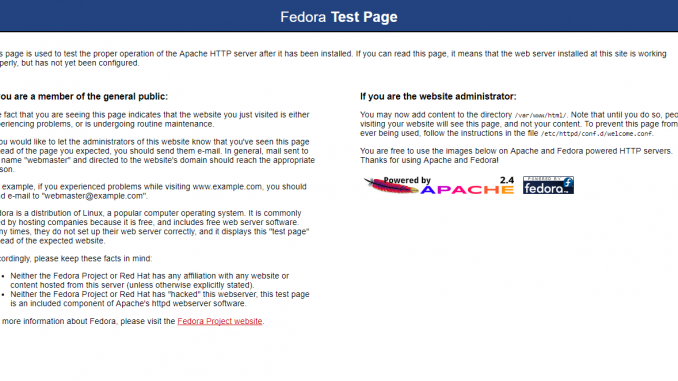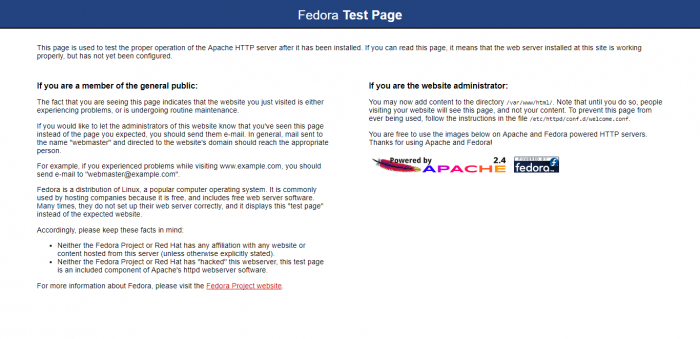
Hello everyone, welcome to Fedora Tutorial. Today we are going to learn how to install LAMP Server on Fedora 27 Server edition. LAMP (Linux Apache MySQL and PHP) is a powerful software combination that will turn your Fedora 27 into a powerful web server. You can then build or run many web applications on top of Fedora 27. If you are running Fedora 26, you can read our post How to install LAMP Server on Fedora 26. It’s pretty similar to that tutorial. You may browse some other tutorial of Fedora 27.
Before we install LAMP Server on Fedora 27, please make sure you have the following items
- root access to the server
- Active internet connection
- Basic understanding of the Linux command line
Steps to Install LAMP Server on Fedora 27
Step 1. Install Fedora 27 Server
I assume you have a running Fedora 27 Server edition, or Workstation edition prior to the LAMP installation. Please read the Fedora 27 Server Installation Guide first.
Step 2. Install Apache Web Server
Log in to Fedora 27 Server via SSH and then paste this command to install Apache. Please note that all of the commands are executed by root user, or normal user with sudo privileges.
su dnf install httpd
Output:
[root@localhost ~]# dnf install httpd Last metadata expiration check: 0:58:42 ago on Wed 18 Oct 2017 11:58:41 AM WIB. Dependencies resolved. ====================================================================================================================== Package Arch Version Repository Size ====================================================================================================================== Installing: httpd x86_64 2.4.28-1.fc27 updates-testing 1.3 M Installing dependencies: apr x86_64 1.6.2-3.fc27 fedora 121 k apr-util x86_64 1.6.0-1.fc27 fedora 102 k fedora-logos-httpd noarch 26.0.1-3.fc27 fedora 33 k httpd-filesystem noarch 2.4.28-1.fc27 updates-testing 29 k httpd-tools x86_64 2.4.28-1.fc27 updates-testing 93 k mod_http2 x86_64 1.10.10-2.fc27 fedora 151 k Transaction Summary ====================================================================================================================== Install 7 Packages Total download size: 1.8 M Installed size: 4.9 M Is this ok [y/N]:
Now start and enable Apache
systemctl enable httpd systemctl start httpd
Modify Firewall to Allow http and https access to the server
firewall-cmd --add-service=http --permanent firewall-cmd --add-service=https --permanent
Now reload firewall configuration
firewall-cmd --reload
Open a web browser and type the Server IP address to test the web server. Make sure you get the following output
At this point, our Apache web server is up and running. Move to the next step.
Step 3. Install and Configure MariaDB
To install MariaDB Server on Fedora 27, use the following command
dnf install mariadb-server
Start and Enable MariaDB Service
systemctl enable mariadb systemctl start mariadb
Secure MariaDB Installation
Now we need to secure the MariaDB installation. Use the following command instead
mysql_secure_installation
You will be asked to change the current root password (none by default).
Output example:
[root@localhost ~]# mysql_secure_installation
NOTE: RUNNING ALL PARTS OF THIS SCRIPT IS RECOMMENDED FOR ALL MariaDB
SERVERS IN PRODUCTION USE! PLEASE READ EACH STEP CAREFULLY!
In order to log into MariaDB to secure it, we'll need the current
password for the root user. If you've just installed MariaDB, and
you haven't set the root password yet, the password will be blank,
so you should just press enter here.
Enter current password for root (enter for none):
OK, successfully used password, moving on...
Setting the root password ensures that nobody can log into the MariaDB
root user without the proper authorisation.
Set root password? [Y/n] y
New password:
Re-enter new password:
Password updated successfully!
Reloading privilege tables..
... Success!
By default, a MariaDB installation has an anonymous user, allowing anyone
to log into MariaDB without having to have a user account created for
them. This is intended only for testing, and to make the installation
go a bit smoother. You should remove them before moving into a
production environment.
Remove anonymous users? [Y/n] y
... Success!
Normally, root should only be allowed to connect from 'localhost'. This
ensures that someone cannot guess at the root password from the network.
Disallow root login remotely? [Y/n] n
... skipping.
By default, MariaDB comes with a database named 'test' that anyone can
access. This is also intended only for testing, and should be removed
before moving into a production environment.
Remove test database and access to it? [Y/n] y
- Dropping test database...
... Success!
- Removing privileges on test database...
... Success!
Reloading the privilege tables will ensure that all changes made so far
will take effect immediately.
Reload privilege tables now? [Y/n] y
... Success!
Cleaning up...
All done! If you've completed all of the above steps, your MariaDB
installation should now be secure.
Thanks for using MariaDB!
Configure firewall to allow MariaDB connection
firewall-cmd --add-service=mysql --permanent firewall-cmd --reload
Done. At this point, MariaDB Server is up and running.
Step 4. Install PHP
Now, we need to install PHP and some additional modules on Fedora 27. Use the following command
dnf install php php-mbstring php-pear
Output:
[root@localhost ~]# dnf install php php-mbstring php-pear Last metadata expiration check: 1:17:57 ago on Wed 18 Oct 2017 11:58:41 AM WIB. Dependencies resolved. ====================================================================================================================== Package Arch Version Repository Size ====================================================================================================================== Installing: php x86_64 7.1.11~RC1-1.fc27 updates-testing 2.8 M php-mbstring x86_64 7.1.11~RC1-1.fc27 updates-testing 593 k php-pear noarch 1:1.10.5-3.fc27 fedora 356 k Installing dependencies: libxslt x86_64 1.1.29-4.fc27 fedora 252 k nginx-filesystem noarch 1:1.12.1-1.fc27 fedora 20 k php-cli x86_64 7.1.11~RC1-1.fc27 updates-testing 4.2 M php-common x86_64 7.1.11~RC1-1.fc27 updates-testing 1.0 M php-fpm x86_64 7.1.11~RC1-1.fc27 updates-testing 1.5 M php-json x86_64 7.1.11~RC1-1.fc27 updates-testing 72 k php-process x86_64 7.1.11~RC1-1.fc27 updates-testing 91 k php-xml x86_64 7.1.11~RC1-1.fc27 updates-testing 225 k Transaction Summary ====================================================================================================================== Install 11 Packages Total download size: 11 M Installed size: 41 M Is this ok [y/N]:
That’s it. Now we have PHP installed.
Conclusion
Installing LAMP Server on Fedora 27 is pretty easy. In few minutes, we can have a powerful web server running on our Fedora 27 Server.
Thanks for reading this How to install LAMP Server on Fedora 27. Please consider share this post if you think its useful. Cheers


Very nice tutorial, well explained with example results. The apache web server loads exactly as planned, but when I tried loading a test.php file with the basic
Need to fix the database install (not dnf instlal mariadb-server)
I tried the phpinfo command and it gave me nothing bu a black screen!
That is a Blank sceen
you must have to restart your httpd service to solve it
The problem your seeing is with the change for how Apache works with PHP in Fedora 27.
You can read about the changes here: https://blog.remirepo.net/post/2017/11/17/Fedora-27-changes-in-http-and-php
And while that explains it, the blog post leaves out a step or two – those can be read here: https://www.server-world.info/en/note?os=Fedora_26&p=httpd&f=13
There may be more than that though. I’m in the middle of trying to get WordPress running on a Fedora 27 server and I’m having trouble that I can’t figure out. It may be related to FPM but I’m not really sure.
Excelente! Claras instrucciones, a seguir desarrollando. Salud y éxito!